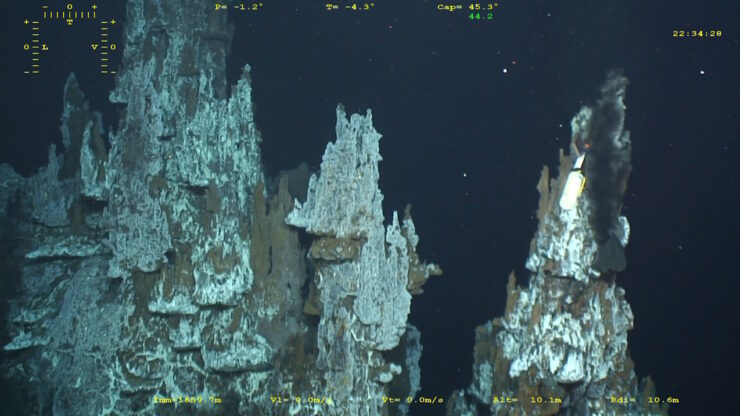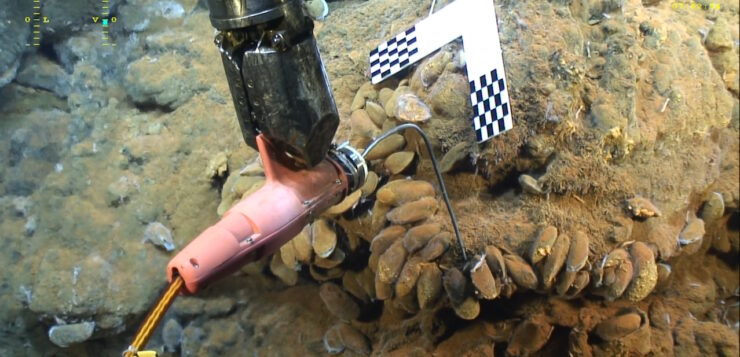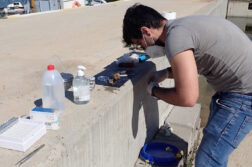This scientific study focused on a still poorly explored area, the Capelinhos hydrothermal edifice, discovered in 2013 in the northern part of the Mid-Atlantic Ridge, at a depth of 1700 meters on the Lucky Strike hydrothermal field. The fluids emitted by these chimneys are potentially more toxic than those of neighboring sites previously studied, with a more acidic pH and higher concentrations of heavy metals. Nevertheless, a rich ecosystem has been discovered, with fauna very similar to that of neighboring source habitats. This discovery is published in the journal Scientific Reports.
A multidisciplinary scientific team from the University of Victoria (Canada), Ifremer (France), the University of Liège (Belgium), and the Blanes Center for Advanced Studies (CEAB-CSIC) studied the fauna of one of the most extreme habitats on the planet: deep-sea hydrothermal vents. More specifically, that of the Capelinhos hydrothermal edifice located 1.5 kilometers from Lucky Strike, a large hydrothermal field located in the northern part of the Mid-Atlantic Ridge off the Azores.
Deep-sea hydrothermal vents are found in areas of intense volcanic and magmatic activity called ridges, where new oceanic crust forms. At these locations, seawater penetrates the seafloor, chemically reacts with hot rocks, and reaches temperatures of up to 400°C before being expelled as hydrothermal fluids, a process similar to that of terrestrial geysers. Specialized fauna colonize these hostile habitats, thanks to the presence of microorganisms capable of producing energy from the chemical compounds in the fluids, rather than using solar energy like the vast majority of primary producers.

The discovery of abundant fauna on a particularly inhospitable hydrothermal edifice
Capelinhos contrasts with the hydrothermal sites in the Lucky Strike field because it presents a more acidic environment (low pH) and higher concentrations of metals, especially iron. Given the potential toxicity of these fluids, scientists expected to find lower diversity and different species from those of nearby edifices. Surprisingly, they discovered a very rich ecosystem, where several species of crustaceans, molluscs, and marine worms thrive, resulting in a faunal composition similar to that of other edifices with less extreme conditions.
Notable differences in food resources and biochemical processes have been observed, allowing these animals to acquire the energy necessary for their survival. Instead of the hydrogen sulphide oxidation processes dominant in other hydrothermal ecosystems, data acquired in this study suggest a more significant role of methane.
The results of this research, published in the journal Scientific Reports, highlight the great environmental and trophic plasticity of hydrothermal vent fauna. They also confirm the significant role of the Bathymodiolus azoricus mussel in faunal communities. Indeed, this “engineering” species induces small turbulences that improve the dilution of metal-rich fluids with seawater, attenuating their concentrations in the environment, thus forming a complex habitat that allows the installation of a diverse associated fauna, despite the strong environmental constraints.
Joan Alfaro Lucas, lead author of the study, currently at the University of Victoria in Canada, comments: “The Capelinhos edifice was recently discovered, and this study is the first to describe its fauna. Our previous knowledge of the chemistry of its fluids led us to think it would be a very inhospitable edifice, even for the specialized fauna of these environments. The fact that these organisms can live at Capelinhos is surprising, but even more so when considering that they use completely different resources than the fauna of neighboring edifices. However, this makes perfect eco-evolutionary sense, as hydrothermal fauna can colonize new habitats and thus maintain populations that ensure their viability in these extreme and dynamic ecosystems.”
Another author, Daniel Martin, a researcher at CEAB-CSIC, emphasizes: “Our study provides not only information on the richness and abundance of life in the ocean depths, still so poorly understood but also highlights the enormous versatility of some marine organisms. Faced with major environmental changes – which may even lead to extreme conditions – there will always be life forms capable of adapting, living, and thriving.”
Jozée Sarrazin, a benthic ecology researcher at Ifremer, who initiated this study, emphasizes: “Our findings help us better understand these unique and inaccessible environments that, more than ever, we must explore. The chemical compounds present in hydrothermal vent fluids, which give life to hydrothermal fauna, also generate mineral deposits that interest industrialists. The potential exploitation of these deposits would cause impacts that are still poorly understood on this fauna, whose extraordinary adaptation capacities are demonstrated today. Without a thorough understanding of the functioning of these ecosystems, no exploitation is reasonable“.
The researchers approach, from another angle, the study of the metabolism of fauna that lives in these extreme environments; a metabolism that appears to be very flexible This opens up new opportunities to explore the incredible ability of living beings to acquire the energy they need to live. By not depending on a specific food source, the range of successfully colonizable environments is expanded.



